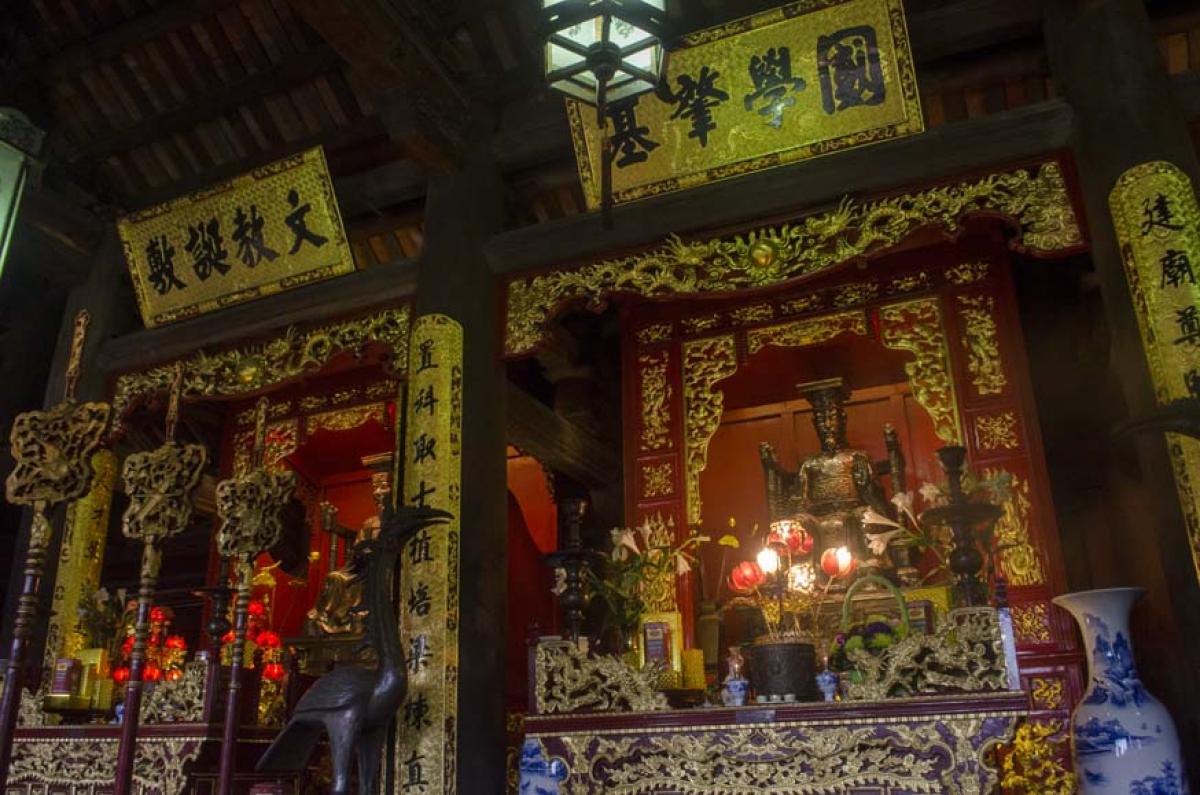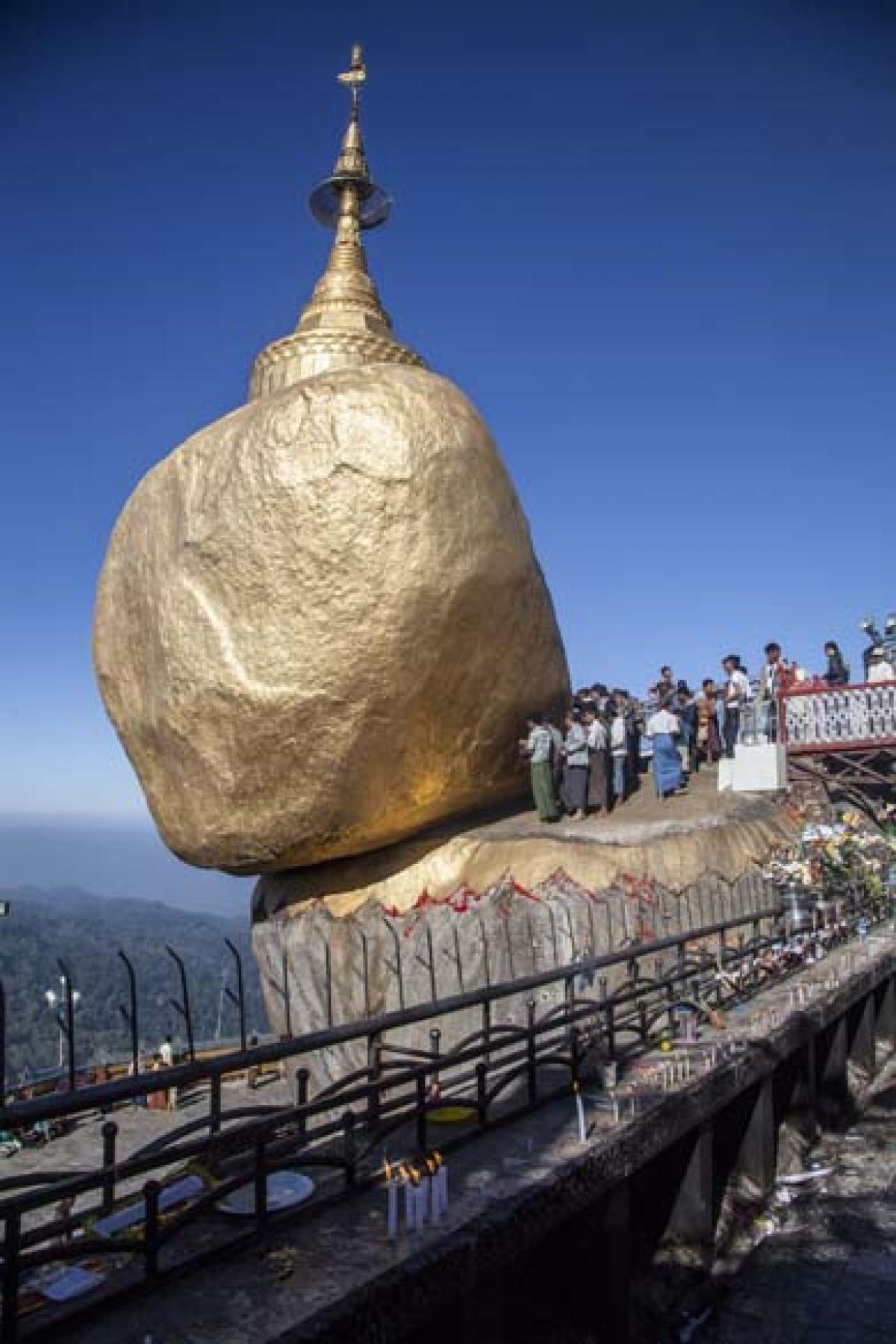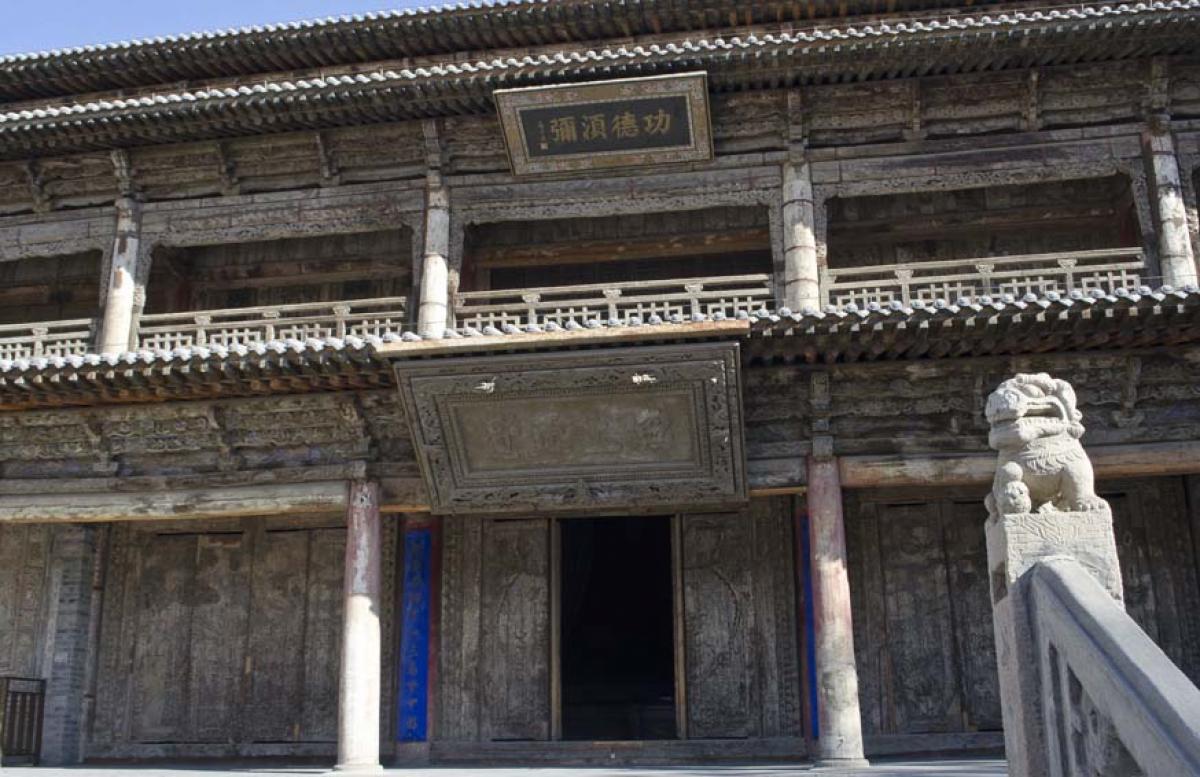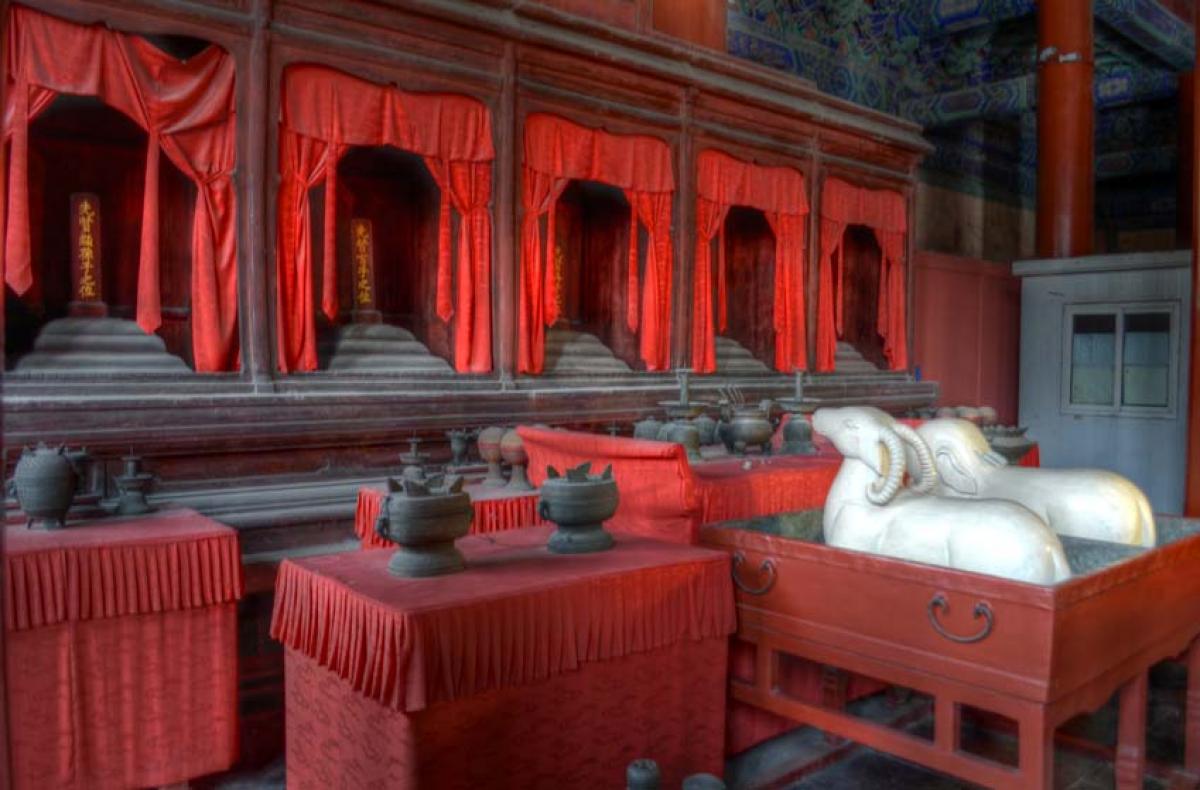Among all the Confucian temples, four in Qufu, Beijing, Rehe, and Shengjing are most prominent throughout history because the Qing emperors would offer funerary rites in honor of Confucius and his followers twice a year. In the late Qing dynasty, 1560 Confucian temples were known to exist in China, with one being placed in nearly every government school (Yu, 2007). Knowing this deep history of Confucianism in China, I wanted to see for myself how the Imperial Academy and Confucius temple looked, and what kind of interesting features it might have.
The first time I had come to the streets surrounding the Confucius temple was to visit the impressive Lama Temple. There was a side street Guozijian, that I had had ventured down, but never taken much interest in. Usually taking other side streets through the other hutongs and wandering to see the various restaurants and boutique clothing shops. I also walked the streets lined with Buddhist paraphernalia, smelling the incense and hearing the Amitabha mantras being broadcast proudly from several of the shops. There are many Thankga painters sitting in the shops painting magnificent Buddhist paintings, and shops selling jewelry and other fine arts.
Now, nearly four years later, having studied Chinese philosophy for the entire Spring semester, I’m finally ready to enter the complex. The entire complex is split in half with the Temple of Confucius on one side and the Imperial Academy on the other. The Temple of Confucius, Beijing was initially built in 1302, with a total of 22,000 square meters, it is the second largest temple constructed for Confucius. The Imperial Academy, Beijing, or Beijing GuoziJian (北京国子监) was built in 1306, by the grandson of Kubilai Khan, and was the supreme academy during the Yuan(1271-1368), Ming(1368-1644) and Qing (1644-1911) dynasties. It covers 37,000 sq meters. Emperors in imperial China would visit the academy and read Confucian books.
Upon entering the complex, I am greeted by a large statue of Confucius. I stand there for several minutes watching how people might react to such an effigy. He is standing with his hands crossed in front of him, and I notice many visitors standing on his side imitating this posture, and others stand before him with their heads bowed in order to give him respect. Many of the people honor this statue of him and seem to have a deep connection either with the spiritual world of Confucius or the philosophical world, both of which seem intertwined.
There are many myths about Confucius’s birth. On the night before Confucius was born, two dragons appeared on the roof; deities hovered in the sky and celestial musicians celebrated on the day of his birth. In addition to forty-nine distinguishing marks on the newborn’s body, his chest bore five characters that announced “Talisman of the one created to stabilized the world”. Then, as an adult, Confucius displayed expertise in identifying ancient relicts and interpreting mystical and magical occurences (Murray, 2009). His body is said to have forty-nine unusual features, which surpasses that of other deities such as thirty marks of Buddha Sakyamuni’s body (Murray, 2009). So he is seen as being an otherworldly being with qualities being more magnificent than a deity in other religious traditions, such as Buddhism.
The cult following of Confucius, and the moral ethical system which he advocated, differs from the religious expressions of China, like Taoism and Buddhism. One similarity is that there are iconic images of him that played a role in receiving sacrificial offerings, and were a standard feature of state temples, like the one in Beijing. These images have varied throughout history according to his rank and status given by the kings of different eras, such as duke, King of Propagating Culture, etc. The status and rank he was given then specified his iconic ornamentation, clothing, and head gear, as well as the number of vessels, music and dancers to be used in the sacrifices. Some later rulers wanted to elevate Confucius beyond the rank of a king to emperor, such as Zhenzong of the Song dynasty, but was opposed and unable to offer the highest level of stat sacrifice that only the ruler could offer. This same emperor tried to change the words of his title to Dark Sage, or Ultimate Sage, for which there was a change in the icongraphy perhaps like in Pingyao where there is a black faced ferocious icon. Other emperors such as the Jin Empoeror Sizong, changed the emblems on the robe from nine to twelve, and the Song emperor Huizong had nine strings of jade increased to twelve. These changes upgraded the visual appearance of the icon from a king to an emperor. Other Ming dynasty emperors increased the number of vessels and dancers in the sacrifices without changing his title. (Murray, 2009).
His ordinary life was not injected with so much grandeur, as his upbringing seems quite humble in origins, and his dedication to becoming a teacher was realized later in life. Confucius belonged to a scribal section of the service class, and served as a keeper of cultural traditions found within the state archival documents. He was a member of a shih family and spent most of his upbringing in poverty. He was forced into managerial and accounting jobs at a young age, and remained unsatisfied professionally and likely never achieved a very high position in his career. He became a philosophical teacher, and transmitter of the Tao, which established him in the history of Chinese civilization. He became a teacher separate from the political order and conveyed his visions directly to his students. His philosophy constitutes much of the “essence” of Chinese culture and his doctrines went on to become the “official philosophy of China.” (Schwartz, 1985)
Confucius advocated for a system of religious which were patterns of behavior that involved ceremonies, manners and general behaviors for the different roles one plays within the family, and all of human society ordered by hierarchical status, rank and position, as well as the heavenly realms. The definition of Li (ritual) is applied not only religious rituals and ancestors, but also living members of one’s family. Through the concrete acts of li one can cultivate an inner heart culture as well as proper behavior in family life, society and government. Jen is defined as the inner moral life of an individual that includes a capacity for self-awareness and reflection, including a submission to li (Schwartz, 1985). Cultivating a virtuous life of Jen is realized through education and training. Confucius believes in educating young disciples according to their desire for education and interest in the topics, and that a proper inner disposition must be there before Confucius can be of any service as a master and teacher. Li and learning are linked together, then jen can be attained and realized in it’s highest form of personal ideal and excellence. (Schwartz, 1985)
The first large statue in the Confucius temple is only one of many images that I will encounter through my journey in the complex. It is considered a temple in the traditional sense, and a temple is a place for worship and sacrifice, so seeing how this is constructed for Confucius I will notice the similarities and differences. Since the complex has over 700 years of history, there are many different objects and images to be discussed.
To the left and right of the Confucius statues are many tortoise steles (bixi) erected in rows up and down the corridor. These are large stone slabs that sit on the back of a tortoise and sitting under a pavilion. The top of the stele is carved with a dragon, said to be one of the nine sons of the Dragon King. Similar steles are found throughout temple complexes for Taoism and Buddhism as well, and serve as important cultural relics sharing information about historical events and calligraphic arts. In addition to the stele in this front courtyard, there are 198 stone tablets contain the names of more than 51,624 jinshi’s (advanced scholars) of the Yuan, Ming and Qing dynasties. They had passed the imperial examnation, which was the civil service exam to select candidates for the state bureaucracy. The test was based on knowledge of classics and literary style. The exam was an important part of Chinese culture and helped to give structure to the intellectual and cultural life. By the Ming Dynasty, the highest degree of jinshi became the highest office, which was much higher than the shengyuan degree that was the initial degree, and required law, math, calligraphy, equestrianism, and archery, in addition to the Confucian classics. By 1370, the examination lasted between 24 and 72 hours and were conducted in spare, isolated examination rooms, or rooms with small cubicles. Students identified themselves by number and tests were recopied by a third person so to prevent the handwriting from being recognized. This system is the root of the National Examination that is in place today, where there are students selected from the college examination system to come to a school like Tsinghua, where only 5000 students per year are chosen out of the millions of students that take the exam annually.
After walking around in that courtyard for some time, then I entered through the first gate inside of the complex, the Gate of Great Accomplishment. Housed within this gate are several large stele with Emperor Qianlong’s handwriting on the top, as well as bells, and then there are ten stone drums The ten stone drums were thought to commemorate a military victory by King Xuan of Zhou. Qianlong wrote a poem that the number of stone drums corresponds to the ten heavenly stems; these stone drums are exceptional ritual objects that have lasted for thousands of years,”(石鼓之數符天干, 千秋法物世已少) (Yu, 2007). The stone drums are replicas of the Western Zhou dynasty, and the inscriptions on the top were recreated by the order of Emperor Qianlong.
After walking through the first gate there are small individual pavilions to the left and right hand side to house 14 important stele. The inscriptions found on these stele are often military stories, and were gifted by various rulers. Manchu rulers installed “gaocheng” stone steles with recounts of the military victories in the Guozijian’s Confucian temple. In 1704, the Kangxi emperor installed his first stele at the Guozijian. Emperor Qianlong erected four steles, all inscribed with texts in both Manchu and Chinese. In this way the Confucian temple became a monument for Manchu imperialism and not only a temple grounds for sages (Yu, 2007). Each stele has a small placard that describes where the stele came from, and whom it was gifted by and when.
There is a large glazed archway, the second gate, that was built in 1783. It was three portals, five, pillars and a roof in Wudianding style. It is covered by yellow glazed tiles, and one tablet has inscriptions written by Emperor Qianlong.
There are cypress trees which line the walkways and planted adjacent to the pavilions. It’s a very beautiful contrast between the red paint and green cypress trees. Walking towards the Confucian temple then I see there is a 700 year old tree named Chujian Bai (Touch Evil Cypress), and legend tells that during the Ming Dynasty a nefarious official named Yan Song passed by the cypress and it took his hat off, and therefor became known for distinguishing good from evil.
Climbing the steps to the Hall of Great Accomplishment, the Confucian temple, I walk past a large stone slab with dragons carved into it. I approach the building and which in appearance is very similar to the Buddhist and Taoist temples that I have visited all around China. The colors and themes are all very similar. When I walked inside, I noticed that there were no statues of Confucian within the, but there are wooden tablets with various calligraphies said to represent him and his students. The wooden tablets were surrounded by sacrificial vessels, and marble animals. New-Confucian ritualists rejected the use of icons in Confucius temples because the classical texts did not include deity worship in the sacrificial rites, and including imagery and icons would alter the character of the sacrifice and change the way that Confucius himself had realized the rituals to be performed. Kong writers stood up for the images, carefully documenting and preserving accounts of the lineage’s images of Confucius throughout the late Zhou to early Han, in order to prove the defense of icons. Then in 1392, Ming founding emperor Taizu, built a new temple for Confucius in Nanjing and ordered images to be removed and replaced by wooden tablets with the names and titles of Confucius. After that the Yongle Emperor allowed for refurbishing of the icons in the imperial academy’s Confucian temple. (Murray, 2009). Today, they want to emphasize this history by using wooden tablets. There are several informational displays with small drawings of Confucius and his students, and no other statues or paintings.
Also within the hall were many of the traditional instruments used for playing music, such as guqin, guzheng, and drums, and bells. Qianlong also used Zhou bronzes as sacrificial offerings on display on the central altars in the Confucian temples. Dacheng Dian 大成殿 (Hall of Great Achievements) during the shidian sacrificial ceremony, Qianlong offered the bronzes to Confucius. Mentioned in the edict were a ding-caldron (鼎), an yi-bowl (彝), an animal-shaped zun-vase (犧尊), a you- bucket (卣), a lei-jar(罍), a hu-vase (壺), a fu- bowl (簠), a gui-bowl (簋), a gu-cup (觚), a jue-cup (爵), a xi-washbowl (洗), and a dragon-spoon (龍勺). The emperor transformed the collectible antiquities into the ritual objects displayed on the altars of shidian ceremonies. In a sense, the group of Zhou bronzes was more like sacrificial offerings placed on an altar, rather than ritual vessels to hold food and drink offered to Confucius. Today the ten bronzes that Qianlong bestowed upon the Confucian temple at the Guozijian are in the National Palace Museum, Taipei. Modern scholars believe that only three of these ten bronzes were cast in the Zhou. They assign one to the Shang and one to the Han, asserting that five others were later copies(Yu, 2007).
Imperial religion involved a cult of gods and spirits listed in the Rites of Zhou. They were serviced by officers of the court and bureaucracy and sanctioned by the Confucian canon. The court condoned specific worship at local temples according to the title of the deity. The Rites of Zhou describes five types of ritual such as capping and marriage, mourning and burial of the dead, which were common to all people. Other rites involved the royal court and social nobility such as the military rites, which brought military personnel together, and guest rituals, which the king used to interact with court nobles and lords. Finally, the auspicious rites, defined man’s relationship to the gods and spirits through sacrifice. (Wilson, 2002).
Emperor Qianlong renovated the Confucian temple in 1768, and donated Zhou bronzes, ten stone drums, and stone steles of the Thirteen classics. During the time of the renovation it was suggested to build a Biyong hall for imperial lectures as found in the ancient rites of the Zhou, and he agreed nine years later. He did this to remind Chinese subjects to honor Machu civilization preserving the traditions of the ancient Zhou (Yu, 2007). The hall is built on a square platform, surrounded by a circular mote, which is reminiscent of ancient beliefs that earth was square and heaven was round. The hall is 17.7 meters in length and width. Entering the hall, I saw the throne and armchair used by previous Emperor’s who came here to give class, there is a geometrical ceiling which is quite mesmerizing. In addition to the hall there are 33 rooms on the east and west sides of the hall. The colors of the temple are mostly a dark red, dark yellow, and black, and I found the outside of the building to be very different in terms of colors and ornamentation from other Buddhist and Taoist temples that I had visited. It is reminiscent of other unique buildings dedicated to the Emperor, such as the Forbidden City or the Temple of Heaven, but the armchair and throne were unique and bright.
After walking through the music hall, I arrive to the final hall of the journey. I walk into one large room and notice rows and rows of stone tablets. The calligrapher Jiang Heng (1672-1742) spent twelve years transcribing the entire Thirteen Classics of over 630,000 characters onto paper, and his work was recognized by Qianlong. He ordered to have the text etched into 190 stone steles and installed in the courtyard of the Guozijian(Yu, 2007). The Book of Changes, Book of History, Book of Songs, Spring and Autumn Annals, the Analects, Mencius, and other Confucian Classics. The hall is filled with long rows of stone tablets, which I walk through.
My impressions of Confucianism were expanded through my visit to the complex. It has amazing history, and I was excited to be able to visit it.
References
Murray, J (2009) “Idols” in the Temple: Icons and the Cult of Confucius. Journal of Asian Studies. 271-411.
Schwartz, B (1985) The World of Thought in Ancient China. Harvard College.
Wilson (2002) Sacrifice and the Imperial Cult of Confucius. History of Religions. The University of Chicago Press. 41:3, 251-287.
Yu, H (2007) The Intersection of Past and Present: The Aianlong Emperor and His Ancient Bronzes. Dissertation. Princeton University.




